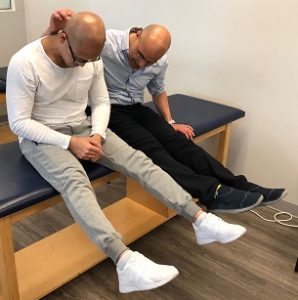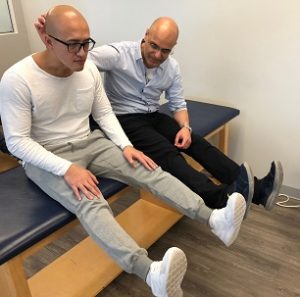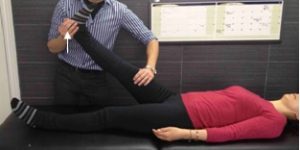Since there are literally over a hundred physical examination techniques for the lumbar spine, I know that assessing a patient with low back pain (LBP) can be quite challenging. However, I want to share with you the 2 valuable tests that I do on most of my patients who present with LBP.
The first test is the Slump test. This 2021 study found the Slump test to have a sensitivity of 85% which is considered excellent for ruling out significant disc bulges.
Place the patient in a slump position with full cervical, thoracic and lumbar flexion, and then add full knee extension and ankle dorsi-flexion.
Calmly tell them that a sensation of a “pull” in the calf and hamstring regions is normal. Ask them about any sharp, pulling, or shooting pain in the low back or down the legs.


Then ask them to extend their neck to neural by simply looking ahead and note any changes in symptoms. If the sensations of sharp, pulling, shooting pain in the low back or down the leg significantly reduce or resolve, then this may be sign of dural/neural sensitivity.
If however the slump position makes no difference to the back or leg symptoms and the looking up does not reduce them, then it is unlikely that the symptoms are due to a large/relevant disc herniation.
I use this as one of the tests to determine if a person is indicated for an MRI. For instance, if they have numbness of their little toe, the inability to plantarflex AND a positive Slump test, I strongly recommend an MRI.
On the other hand if they have vague pain in their lumbar spine and down one or both legs and the Slump test make little or no difference to their symptoms, then an MRI is unwarranted (unless there are other red flags).
The second physical examination I do on every patient with LBP is the straight leg raise (SLR) test. The SLR, which is also referred to as the Laségue sign has been shown to have a sensitivity of only 28%. The SLR is therefore less sensitive than the Slump test for either detecting or ruling out a relevant disc bulge.

“…the slump test presents superior sensitivity compared with the Laségue sign for both the diagnosis of hernia and disc bulging” – Miranda et al 2021
However, I do rely on the crossed SLR to evaluate the presence of a large lumbar disc herniation. The test is positive if the SLR on the non-symptomatic leg reproduces the patient’s radicular pain down the contra-lateral leg.
Based on this 2008 paper, a person presenting with positive ipsi-lateral or crossed SLR and Slump tests, who also has any kind of myotomal or dermatomal findings, should ideally get an MRI.
Hopefully by the time they actually get the MRI, their symptoms would have resolved by then, but we should at least start the process.
“…the SLR test may especially help identify patients who have herniations with root compression requiring surgery”– Majlesi et al 2008

